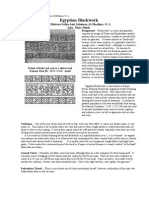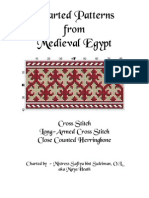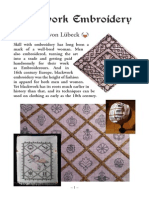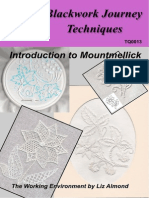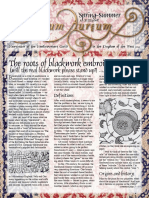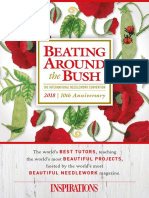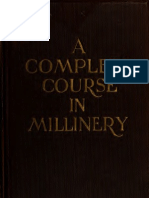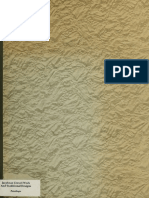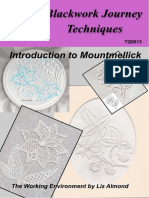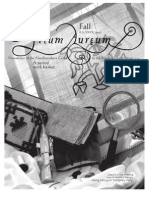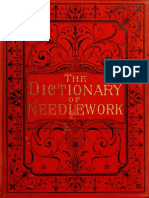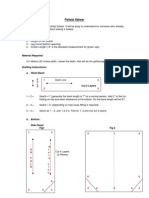WW
WW
Uploaded by
PlainJennCopyright:
Available Formats
WW
WW
Uploaded by
PlainJennOriginal Title
Copyright
Available Formats
Share this document
Did you find this document useful?
Is this content inappropriate?
Copyright:
Available Formats
WW
WW
Uploaded by
PlainJennCopyright:
Available Formats
To my husband, Fernando, and my daughters, Alexandra and Morgan,
in atonement for all the times Ive said Wait a second, Im counting!
Kathryn Newell/Mistress Kathryn Goodwin, OL
for more than three decades of encouragement
Alexandra Salazar
for the mechanics of multiple layer drawing, and drafting methods used
Michael Greenberg/ Master Arnoff Ragnarsson, OP
for guidance on graphics platforms suitable for pattern production
House Oldcastle and its extended clan
also for more than three decades worth of encouragement
Merlyn Liberty
for advice on intellectual property rights
1978, 2010, 2011, Kim Brody Salazar
All Rights Reserved
Black Rose Press, Arlington, Massachusetts
1978, 2010,2011 Kim Brody Salazar Intended for private use kbsalazar@comcast.net
Please contact author for commercial, nonprofit, or reproduction rights http://www.string-or-nothing.com
In fulfillment of long standing promises, I release this collection of counted filling patterns.
This collection represents a re-issue of material I originally published in my first booklet
Blackwork Embroidery (1975), augmented by material Ive sketched and used in the
intervening years, and by totally new material created for this collection.
These repeating patterns are most often found as fillings in inhabited blackwork, a
historical embroidery style is typified by heavily outlined twining flower, leaf or fruits, with
each constituent shape filled in by small geometrics (Figure 1).
This style of stitching was common in the middle to late 1500s, and was particularly
popular in England, where it was used widely for clothing and personal accessories, and
for cushions, pillow covers and to adorn other household linens. By contrast, modern
blackwork tends to dispense with the outlines, and uses the fillings more as an engraver
would use stippling or shading, similar to the modeling of shadow and depth found on
most countries printed currency. Not every piece of historical blackwork conformed to
the heavy outline/geometric filling convention. Many were worked with freehand as
opposed to counted fills, some with small stippling stitches scattered to produce shading,
or to fill the background areas. Others added metal threads, beads, pearls or spangles
to the stitching. But this collection of fills concentrates on the style family of diapered
geometric fills.
In addition to use as fills, some of these patterns (especially the larger, more elaborate
repeats) show up free-standing (Figure 2). Famous samplers including the Jane
Bostocke sampler of 1598 (Victoria & Albert Museum, accession T.190-1960) include
panels of geometrics suitable for use as all over patterns alongside strip type patterns
and freehand drawn motifs. As larger field treatments, these patterns occur on garment
sleeves, smock and chemise yokes, other personal linen, and on small goods, including
pin cushions and sweet bags.
Please note that just because the styles of fillings are lumped together and called
blackwork, not all geometrics were done entirely in black, or even in monotone. High
Figure 1. Stitched by the author, left in the early 1990s, right in 1974-1975,
both using many of the patterns in this collection.
1978, 2010,2011 Kim Brody Salazar Intended for private use kbsalazar@comcast.net
Please contact author for commercial, nonprofit, or reproduction rights http://www.string-or-nothing.com
contrast colors were popular,
including deep crimson red, forest
green, or deep indigo/navy blue. The
Bostocke sampler shows geometrics
worked in multiple colors and with
metallic threads. Nor was all
stitching done using only one
thickness of thread. The bottom-
most band in Figure 2 has a flowery
foreground worked with thicker
thread than the background grid.
Pattern origins vary. Although many
of these filling patterns were drafted
from period sources, many are of my
own invention. I have no lists of
citations for the patterns I have
drafted from source materials over
the years. Back when I began
collecting fill patterns, I did not keep
documentation with full annotations.
The majority of the patterns in the
first 14 plates date from my original
circa 1974-1980 hand-drawn
collections.
Patterns I clearly remember doodling
up myself I have marked with a .
Some of the starred items are
adaptations of designs Ive published elsewhere, many of which do have specific
historical sources, so the patterns here can be thought of as being inspired by. Others
are products of my fancy. In doodling up new patterns I noted that the overwhelming
majority of historical geometrics of this type stick to some simple rules of composition
most notably, the use of straight lines, 90 and 45 angles, corresponding to the angles
found in a boxed X. There are some exceptions, patterns that employ 60 and 30
angles (two boxes over, one up, or knights move spacing) but theyre uncommon. For
the most part, I stuck to straight lines, 90 and 45 angles. Exceptions are footnoted in
the pattern pages.
I also avoided an obvious style family in compiling this work patterns based on fylfots;
the broken cross made infamous by the Nazi party. This is an ideological rather than a
historical or aesthetic choice on my part. The symbol was used in historical works.
I would not have an issue with the use of most of the patterns in this booklet on original
artifacts intended to reproduce the look/feel of historical dress or linens. The small and
medium size geometrics are very typical of historical fills. Some of the larger repeats
(marked with s) have no historical cognate. This is especially true of the figural fills,
#169 and #210 have no historical basis whatsoever.
Some re-creators subscribe to the exact-stitch-only school of reproduction, and prefer
specific source annotations for each and every filling pattern used. I observe that while
some pattern books include a small number of all-over patterns that can be used as
fillings no printed collections of filling patterns explicitly meant for blackwork have come
down to us from the 1500s, and samplers showing the fillings used in inhabited
blackwork are very rare. The only sources for filling patterns are actual embroidered
Figure 2. Portion of sampler stitched by the
author. Second band from the top includes
three patterns from this collection, worked as
field fillings.
1978, 2010,2011 Kim Brody Salazar Intended for private use kbsalazar@comcast.net
Please contact author for commercial, nonprofit, or reproduction rights http://www.string-or-nothing.com
artifacts and paintings. Paintings of course are problematic because artists were more
concerned with total effect than stitch by stitch renderings. I am willing to accept that
stitchers copied or made up their filling designs as they went along. Feel free to
disagree.
The patterns in this book are best suited for line unit stitchery. Double running stitch (aka
Spanish Stitch, Holbein Stitch, Punto Scritto) is a natural, and using it many, but not all of
these designs can be stitched double sided. Patterns using continuous lines with no
islands or orphaned areas are candidates for double sided double running stitch. Other
forms of straight line stitchery were occasionally used to create these. Folk who shy
away from the logic of double running and who are not concerned about making the front
and back identical can use back stitch or chain stitch if they so prefer.
These patterns were most commonly worked on linen. Any modern even-weave linen
can be used. For the most authentic look choose a high-count ground fabric, preferably
a plain weave that does not feature easy to spot emphasized holes. (Modern Aida or
Hardanger cloth both have easy to see, emphasized holes.) Historical examples were
generally worked on finer weave linen than most contemporary linens sold for stitching. It
was not unusual for double running to be worked over three or four threads of a ground
fabric of around 60 or more threads per inch. My own works tend to be done on more
readily obtained 36 count linen, stitched over 2x2 threads per inch.
For threads historical works used floss silk, often of more than one thickness. Further
embellishment with metal threads, beads or spangles was also common. I use modern
cotton or silk embroidery floss. The fragment of my coif (shown in progress, Figure 1,
left) is worked on 50 count linen using Kreinik Soie DAlger. Figure 2 is worked on 36
count linen using DMC cotton embroidery floss.
My first book, The New Carolingian Modelbook: Counted Embroidery Patterns from
Before 1600 was named in honor of my once and now present home in the Society for
Creative Anachronism (SCA) the Barony of Carolingia (Greater Boston/Cambridge,
Massachusetts area). But while I was working on the book I had removed to another
SCA district, part of the Kingdom of Atlantia (Roughly the US Seaboard region from
Maryland to South Carolina). At that time I promised to name my second book
accordingly. You now have that book before you.
I distribute this book for free because more than half of it is a republication, because of
the paucity of source material citations, and because I want to encourage more people to
stitch with originality and imagination. However, I do not relinquish my rights as author
because I do not charge for this work. Please respect my copyright. Please keep this
book intact, do not distribute individual patterns or pages. Please do not re-issue it,
publish it in paper or electronic format, or sell it or excerpts from it (even for charity)
without obtaining my specific permission.
May these patterns inform your creativity, and fill your hours with joy.
Countess Ianth, dAveroigne, OL, OR, QoC, CCoM
Kim Brody Salazar
1978, 2010,2011 Kim Brody Salazar Intended for private use kbsalazar@comcast.net
Please contact author for commercial, nonprofit, or reproduction rights http://www.string-or-nothing.com
1 2
3 4
5 6
#5 the center of the star is stitched off grid.
1978, 2010,2011 Kim Brody Salazar Intended for private use kbsalazar@comcast.net
Please contact author for commercial, nonprofit, or reproduction rights http://www.string-or-nothing.com
7 8
9 10
11 12
#10 The background fill between the crosses is stitched off grid.
1978, 2010,2011 Kim Brody Salazar Intended for private use kbsalazar@comcast.net
Please contact author for commercial, nonprofit, or reproduction rights http://www.string-or-nothing.com
13 14
15 16
17 18
1978, 2010,2011 Kim Brody Salazar Intended for private use kbsalazar@comcast.net
Please contact author for commercial, nonprofit, or reproduction rights http://www.string-or-nothing.com
19 20
21 22
23 24
1978, 2010,2011 Kim Brody Salazar Intended for private use kbsalazar@comcast.net
Please contact author for commercial, nonprofit, or reproduction rights http://www.string-or-nothing.com
25 26
27 28
29 30
You might also like
- A-Z of Embroidery Stitches PDFDocument67 pagesA-Z of Embroidery Stitches PDFLiran Shani89% (37)
- A Year of Embroidery - Sample Projects PDFDocument34 pagesA Year of Embroidery - Sample Projects PDFSema Alpaytac84% (43)
- Egyptian Medieval BlackworkDocument9 pagesEgyptian Medieval BlackworkMaya Heath67% (3)
- The Stitch Bible PDFDocument19 pagesThe Stitch Bible PDFGabriela De Arriola32% (28)
- Black Salve RecipeDocument24 pagesBlack Salve RecipePlainJenn100% (1)
- L'Arte Del BlackworkDocument97 pagesL'Arte Del BlackworkSindicato Telefonistas Seccion100% (10)
- Menagerie: Teeny TinyDocument124 pagesMenagerie: Teeny TinyLeila Azevedo100% (16)
- Artistic EmbroideryDocument146 pagesArtistic Embroiderygab2093% (43)
- Charted Patterns From Medieval Egypt - Cross Stitch, Long-Armed Cross Stitch, Counted HerringboneDocument46 pagesCharted Patterns From Medieval Egypt - Cross Stitch, Long-Armed Cross Stitch, Counted HerringboneMaya Heath100% (23)
- Blackwork Embroidery Booklet v2Document20 pagesBlackwork Embroidery Booklet v2Drucila75% (4)
- English Blackwork FillworkDocument17 pagesEnglish Blackwork FillworkRanaWardeh100% (4)
- TQ0013 Introduction To MountmellickDocument6 pagesTQ0013 Introduction To Mountmellicktislm1100% (1)
- The Roots of Blackwork Embroidery: Spring-SummerDocument10 pagesThe Roots of Blackwork Embroidery: Spring-Summersandhya v100% (2)
- BRODERIEDocument45 pagesBRODERIEpacostica288892% (24)
- Batb2018 PDFDocument40 pagesBatb2018 PDFKlaudia Maria Lewicka50% (8)
- (1919) A Complete Course in MillineryDocument180 pages(1919) A Complete Course in MillineryHerbert Hillary Booker 2nd100% (4)
- (1919) A Complete Course in MillineryDocument180 pages(1919) A Complete Course in MillineryHerbert Hillary Booker 2nd100% (4)
- Cotton Web ReportDocument30 pagesCotton Web ReportHumaRiaz33% (3)
- Quality Guideline of JCPENNYDocument33 pagesQuality Guideline of JCPENNYKumar Rishikesh80% (5)
- DGFT DataDocument195 pagesDGFT DatakPrasad8No ratings yet
- Blackwork Embroidery Booklet v2Document20 pagesBlackwork Embroidery Booklet v2profe28m100% (7)
- Blackwork Documentation WebpageDocument8 pagesBlackwork Documentation Webpageapi-11509044575% (4)
- Counted Blackwork Handout1Document8 pagesCounted Blackwork Handout1api-115090445No ratings yet
- 139 Needlework Books OnlineDocument25 pages139 Needlework Books OnlineEmerson Breno100% (7)
- English Embroidery - I - Double-Running or Back-StitchFrom EverandEnglish Embroidery - I - Double-Running or Back-StitchRating: 5 out of 5 stars5/5 (1)
- Blackwork A New Approach by Brenda DayDocument108 pagesBlackwork A New Approach by Brenda DaySCP86% (7)
- (1908) Embroidery Lessons With Colored StudiesDocument156 pages(1908) Embroidery Lessons With Colored StudiesHerbert Hillary Booker 2nd89% (38)
- Embroidery ManualDocument36 pagesEmbroidery ManualVictoria Nagy100% (10)
- Scandinavian Stitch Craft - Unique Projects and Patterns For Inspired Embroidery PDFDocument143 pagesScandinavian Stitch Craft - Unique Projects and Patterns For Inspired Embroidery PDFLiran Shani96% (26)
- (1880) Hand-Book of EmbroideryDocument12 pages(1880) Hand-Book of EmbroideryHerbert Hillary Booker 2nd90% (10)
- Charlene Mullen Catalogue 150dpiDocument16 pagesCharlene Mullen Catalogue 150dpidelaespada67% (3)
- (1879) Art-Needlework For Decorative EmbroideryDocument126 pages(1879) Art-Needlework For Decorative EmbroideryHerbert Hillary Booker 2nd88% (17)
- Jacobean Crewe Lwo 00 PeneDocument50 pagesJacobean Crewe Lwo 00 PeneAndrew Olsen100% (8)
- TQ0013 Introduction To MountmellickDocument6 pagesTQ0013 Introduction To MountmellickevachNo ratings yet
- A Book of Old Embroidery 1921 - Kendrick Albert Frank & Charles Geoffrey HolmeDocument150 pagesA Book of Old Embroidery 1921 - Kendrick Albert Frank & Charles Geoffrey Holmeje_wella100% (3)
- Stitches and Samples BookDocument240 pagesStitches and Samples BookChristine Gow95% (22)
- Church Needlework PDFDocument122 pagesChurch Needlework PDFanahi esquivel100% (2)
- Encyclopedia of Needlework (Ill - Therese de DillmontDocument2,261 pagesEncyclopedia of Needlework (Ill - Therese de DillmontAmber McDonald91% (23)
- Artistic Embroide 1880 ChurDocument148 pagesArtistic Embroide 1880 ChurDiego Ribeiro100% (3)
- Mary Symonds - Elementary EmbroideryDocument192 pagesMary Symonds - Elementary Embroideryenglishembroidery100% (2)
- The Dictionary of Needlework - Caulfeild, Frances, Saward (1885) Vol. 5Document170 pagesThe Dictionary of Needlework - Caulfeild, Frances, Saward (1885) Vol. 5va76100% (3)
- Cs 34y Hardinger-EmbroideryDocument5 pagesCs 34y Hardinger-EmbroideryMaria Airam33% (3)
- Stitch Patterns & Design For EmbroideryDocument18 pagesStitch Patterns & Design For EmbroideryPloumisth Paraskeua100% (8)
- (1905) Eyelet Embroidery and Its Future PossibilitiesDocument36 pages(1905) Eyelet Embroidery and Its Future PossibilitiesHerbert Hillary Booker 2nd100% (10)
- (1882) Patterns For Needle WorkDocument28 pages(1882) Patterns For Needle WorkHerbert Hillary Booker 2nd86% (7)
- EncyclopediaOfRibbonEmbroideryBordersDocument59 pagesEncyclopediaOfRibbonEmbroideryBordersmrlgnc95% (19)
- Embroidery Collection 5Document84 pagesEmbroidery Collection 5Dariusz Adamek100% (7)
- (1853) The Ladies' Self: or in Millinery & Mantua MakingDocument244 pages(1853) The Ladies' Self: or in Millinery & Mantua MakingHerbert Hillary Booker 2nd100% (11)
- Stitch Library EmbriodaryDocument23 pagesStitch Library EmbriodarySonam Mehta100% (11)
- Embroidery or The Craft of The Needle - W Townsend (1907)Document332 pagesEmbroidery or The Craft of The Needle - W Townsend (1907)Cary MacMahon-dann80% (5)
- (1886) Hand-Book: Domestic Decorative Art NeedleworkDocument44 pages(1886) Hand-Book: Domestic Decorative Art NeedleworkHerbert Hillary Booker 2nd91% (11)
- A Period Workbox - Fall 2005Document8 pagesA Period Workbox - Fall 2005zari4711No ratings yet
- The Dictionary of Needlework - Caulfeild, Frances, Saward (1885) Vol. 1Document176 pagesThe Dictionary of Needlework - Caulfeild, Frances, Saward (1885) Vol. 1va76100% (1)
- Guia de PuntosDocument23 pagesGuia de PuntosL31p24100% (3)
- Hand EmbroideryDocument41 pagesHand EmbroideryJanice Blanco89% (9)
- Leavers Lace - A Hand Book of the American Leaver Lace IndustryFrom EverandLeavers Lace - A Hand Book of the American Leaver Lace IndustryRating: 3 out of 5 stars3/5 (1)
- The Complete Recorder Care GuideDocument26 pagesThe Complete Recorder Care GuidePlainJennNo ratings yet
- The Complete Recorder Care GuideDocument26 pagesThe Complete Recorder Care GuidePlainJennNo ratings yet
- Continuous Thread String HeddlesDocument2 pagesContinuous Thread String HeddlesPlainJennNo ratings yet
- How To Make A BiscornuDocument0 pagesHow To Make A BiscornuPlainJennNo ratings yet
- Well Dress D PeasantDocument73 pagesWell Dress D PeasantPlainJenn100% (2)
- DMC-FZ35: Operating Instructions For Advanced FeaturesDocument0 pagesDMC-FZ35: Operating Instructions For Advanced FeaturesPlainJennNo ratings yet
- Drafting Patiala SalwarDocument3 pagesDrafting Patiala SalwarPln ReddiNo ratings yet
- Textile CraftsDocument8 pagesTextile CraftsAkhil KaushikNo ratings yet
- Overview of HEDocument13 pagesOverview of HEJohn walkerNo ratings yet
- The Industrial Revolution: By: Inaya Noor 7CDocument4 pagesThe Industrial Revolution: By: Inaya Noor 7Cinaya noorNo ratings yet
- Brief Industrial Profile of Munger District: LR Eso T RsDocument14 pagesBrief Industrial Profile of Munger District: LR Eso T Rsgo backNo ratings yet
- Risks and Management of Textile WasteDocument25 pagesRisks and Management of Textile WasteAbril MonsalveNo ratings yet
- Elena Frangakis-Syrett The Ottoman Port of Izmir in The Eighteenth and Early NineteenthDocument15 pagesElena Frangakis-Syrett The Ottoman Port of Izmir in The Eighteenth and Early NineteenthBurcu BabayiğitNo ratings yet
- How To Make Your Fragrance Last LongerDocument13 pagesHow To Make Your Fragrance Last LongerDele AwosileNo ratings yet
- Puteri Wulandari (19134068) - Mini Proposal BIBDocument8 pagesPuteri Wulandari (19134068) - Mini Proposal BIBputeriNo ratings yet
- TextDocument43 pagesTextshockwave1665No ratings yet
- International Cotton Association Rules 2010 - Rule BookDocument107 pagesInternational Cotton Association Rules 2010 - Rule BookcottontradeNo ratings yet
- Production System: Features of A Progressive Bundle Unit SystemDocument3 pagesProduction System: Features of A Progressive Bundle Unit SystemdivyaNo ratings yet
- Defects PDFDocument128 pagesDefects PDFBhaswati PandaNo ratings yet
- One Shoulder Dog Dress PatternsDocument7 pagesOne Shoulder Dog Dress Patternskevynkay100% (2)
- Muscle Car Interior Restoration - Where To StartDocument65 pagesMuscle Car Interior Restoration - Where To Startkirthi83No ratings yet
- Knit An Audrey Hepburn DollDocument4 pagesKnit An Audrey Hepburn DollSuzanne Yates ByfordNo ratings yet
- Mir - Ahammed - Ali-Dyeing ManagerDocument4 pagesMir - Ahammed - Ali-Dyeing ManagerRafsun HimelNo ratings yet
- Mi Futura ProfesiónDocument12 pagesMi Futura ProfesiónStephania Caroca AcevedoNo ratings yet
- Cover Page Demo For SEUDocument4 pagesCover Page Demo For SEUtarif sbsbdNo ratings yet
- British GQ June 2017 PDFDocument351 pagesBritish GQ June 2017 PDFcrobelo750% (2)
- Contineous Dyeing of Reactive DyesDocument9 pagesContineous Dyeing of Reactive DyesMohammed Atiqul Hoque ChowdhuryNo ratings yet
- Arsons Report FinalDocument37 pagesArsons Report FinalKhadija FayazNo ratings yet
- Men StyleDocument12 pagesMen StyleTheCosmicFlowNo ratings yet
- Needlepoint: From Wikipedia, The Free EncyclopediaDocument8 pagesNeedlepoint: From Wikipedia, The Free EncyclopediaAlexandra Maria NeaguNo ratings yet
- Indian Disinfectant Players - Apr 08Document4 pagesIndian Disinfectant Players - Apr 08Sanjukt K. SahaNo ratings yet
- E-Commerce Apparel Business ConceptDocument20 pagesE-Commerce Apparel Business ConceptApurv Sinha100% (1)
- Filters: Women's FootwearDocument5 pagesFilters: Women's Footweartariku1611No ratings yet
- Tata Textile IntroductionDocument7 pagesTata Textile IntroductionManisha BhanushaliNo ratings yet


